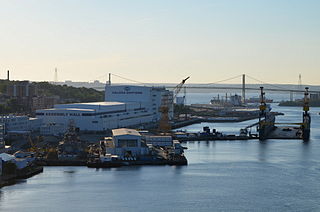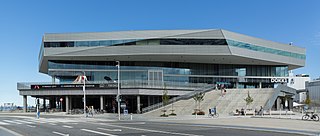
Aktien-Gesellschaft „Weser" was one of the major German shipbuilding companies, located at the Weser River in Bremen. Founded in 1872 it was finally closed in 1983. All together, A.G. „Weser" built about 1,400 ships of different types, including many warships. A.G. „Weser" was the leading company in the Deutsche Schiff- und Maschinenbau AG, a cooperation of eight German shipbuilding companies between 1926 and 1945.
Burmeister & Wain was a large established Danish shipyard and leading diesel engine producer headquartered in Copenhagen, Denmark. Founded by two Danes and an Englishman, its earliest roots stretch back to 1846. Over its 150-year history, it grew successfully into a strong company through the end of the 1960s. In the 1970s, global competitive pressures, particularly from the far east, began to take their toll. In 1980, B&W became MAN B&W Diesel A/S, part of MAN B&W Diesel Group, a subsidiary of the German corporation MAN AG, with operations worldwide. The company still maintains operations at three main sites in Denmark for manufacturing, servicing, and licensing of its two-stroke engines and complete propulsion systems.

Vigor Shipyards is the current entity operating the former Todd Shipyards after its acquisition in 2011. Todd Shipyards was founded in 1916, which owned and operated shipyards on the West Coast of the United States, East Coast of the United States and the Gulf. Todd Shipyards were a major part of the Emergency Shipbuilding Program for World War II.
Toronto Drydock Company is a shipbuilding repair company in Canada and the name of two shipbuilders in the 19th and 20th centuries respectively.

The Federal Shipbuilding and Drydock Company was a United States shipyard, active from 1917 to 1948. It was founded during World War I to build ships for the United States Shipping Board. During World War II, it built ships as part of the U.S. Government's Emergency Shipbuilding program. Operated by a subsidiary of the United States Steel Corporation, the shipyard was located at Kearny Point where the mouth of the Hackensack River meets Newark Bay in the Port of New York and New Jersey. The shipyard site is now part of River Terminal, a massive distribution facility that is partially a foreign trade zone.

Burrard Dry Dock Ltd. was a Canadian shipbuilding company headquartered in North Vancouver, British Columbia. Together with the neighbouring North Van Ship Repair yard and the Yarrows Ltd. yard in Esquimalt, which were eventually absorbed, Burrard built over 450 ships, including many warships built and refitted for the Royal Navy and Royal Canadian Navy in the First and Second World Wars.

The Halifax Shipyard Limited is a Canadian shipbuilding company located in Halifax, Nova Scotia.
Royal Denship was a Danish multi-facility conglomerate ship and yacht builder. Presently in administration, the company has created some of the world's largest super yachts.

Aarhus River is a 40-kilometre (25 mi) long river or stream, in eastern Jutland, Denmark.

Todd Pacific Shipyards, Los Angeles Division was a shipyard in San Pedro, Los Angeles, California. Before applying its last corporate name, the shipyard had been called Los Angeles Shipbuilding & Dry Dock Company and Todd Shipyards, Los Angeles Division. Under those three names, the San Pedro yard built at least 130 ships from 1917 to 1989.

Bay Shipbuilding Company (BSC) is a shipyard and dry dock company in Sturgeon Bay, Door County, Wisconsin. As of 2015, Bay Ships was a subsidiary of Fincantieri Marine Group and produces articulated tug and barges, OPA-90 compliant double hull tank ships and offshore support vessels. It also provides repair services to the lake freighter fleet. In the past the shipyard located in Sturgeon Bay has operated under several different names and traces its history back to 1918.

The 1944 explosion in Aarhus or the 4th of July Disaster was an explosion in the city of Aarhus, Denmark when a barge loaded with ammunition exploded in the harbor, killing 39 people and injuring another 250.
The following is a timeline of the history of the city of Aarhus, Central Denmark Region, Denmark.

Dokk1 or Dokken is a government building, public library and culture center in Aarhus, Denmark. It is situated on Hack Kampmanns Plads in the city center by the waterfront next to the Custom House. Dokk1 is part of the much larger development project Urban Mediaspace Aarhus, jointly financed by Aarhus Municipality and Realdania for 2.1 billion DKK. It is designed by Schmidt Hammer Lassen Architects and Kristine Jensen, with construction managed by NCC AB. Construction broke ground 8 June 2011 and the building was inaugurated four years later on 20 June 2015.
Aktiebolaget Sandvikens Skeppsdocka och Mekaniska Verkstad was a Finnish shipbuilding and engineering company that operated in Helsinki in 1895–1938. The company was set up to continue shipbuilding at Hietalahti shipyard, after its predecessor Helsingfors Skeppsdocka, which operated the yard in 1865–1895, had bankrupted.

An auxiliary floating drydock is a type of US Navy floating dry dock. Floating dry docks are able to submerge underwater and to be placed under a ship in need of repair below the water line. Water is then pumped out of the floating dry dock, raising the ship out of the water. The ship becomes blocked on the deck of the floating dry dock for repair. Most floating dry docks have no engine and are towed by tugboats to their destinations. Floating dry docks come in different sizes to accommodate varying ship sizes, while large floating dry docks come in sections and can be combined to increase their size and lift power. Ballast pontoon tanks are flooded with water to submerge or pumped dry to raise the ship.

USS AFDM-2,, is an AFDM-3-class medium auxiliary floating drydock built in Mobile, Alabama by the Alabama Drydock and Shipbuilding Company for the U.S. Navy. Originally named USS YFD-4, Yard Floating Dock-4, she operated by Todd Shipyards at New Orleans, Louisiana for the repair of US ships during World War II. YFD-4 was renamed an Auxiliary Floating Dock Medium AFDM-2 in 1945 after the war.
Everett-Pacific Shipbuilding & Dry Dock Company was established in 1942 to build ships needed for World War II. As part of the Emergency Shipbuilding Program the US Navy provided some of the capital to start Everett-Pacific Shipbuilding at Port Gardner Bay in Everett, Washington. Everett-Pacific was sold in 1945 to the Pacific Car and Foundry, who was already a major manufacturer of railcars and trucks. Pacific Car and Foundry was building barges for the US Navy during World War II at plants in Renton, Seattle and Tacoma in the state of Washington. The lease for the shipyard in Everett, Washington ended in 1949 and the yard closed. Pacific Car and Foundry in 1972 changed its name to Paccar Inc. to reflect its major products. The Everett-Pacific shipyard site later became part of Western Gear, a heavy machinery manufacturer. in 1987 the shipyard became part of Naval Station Everett. Everett-Pacific Shipbuilding was started by William Pigott Jr. a Seattle businessmen and his brother Paul Pigott (1900-1961). William Pigott Jr. was born in 26 Aug. 1895 in Pueblo, CO and died on 8 July 1947 in San Francisco, CA.

Hurley Marine Shipyard of Hurley Marine Works also site of Naval Reserve Armory, Oakland and the Naval Industrial Reserve Repair Facility, Oakland was a shipyard in Oakland, California. The Hurley Marine Shipyard opened in 1940, in 1951 the yard was operated by Crowley Maritime Corporation. In 1964 the site was operated by Pacific Dry Dock and Repair Company. The shipyard closed in 1992, today most of the shipyard is vacant land with part of the land now Leal Seal Boat Works owned by Leal Charonnat, of Leal Charonnat - Architect & Engineering. A small boatyard operated at the site from 1935 to 1940. The shipyard was located at 321 Embarcadero Oakland on the San Francisco bay, Inner Oakland Harbor. Crowley Maritime Corporation was the parent corporation of Pacific Dry Dock, which used the shipyard to repair its fleet of tugboats and other ships. Pacific Dry Dock also operated a shipyard across from Coast Guard Island till 1991 at 1414 Embarcadero Oakland.













